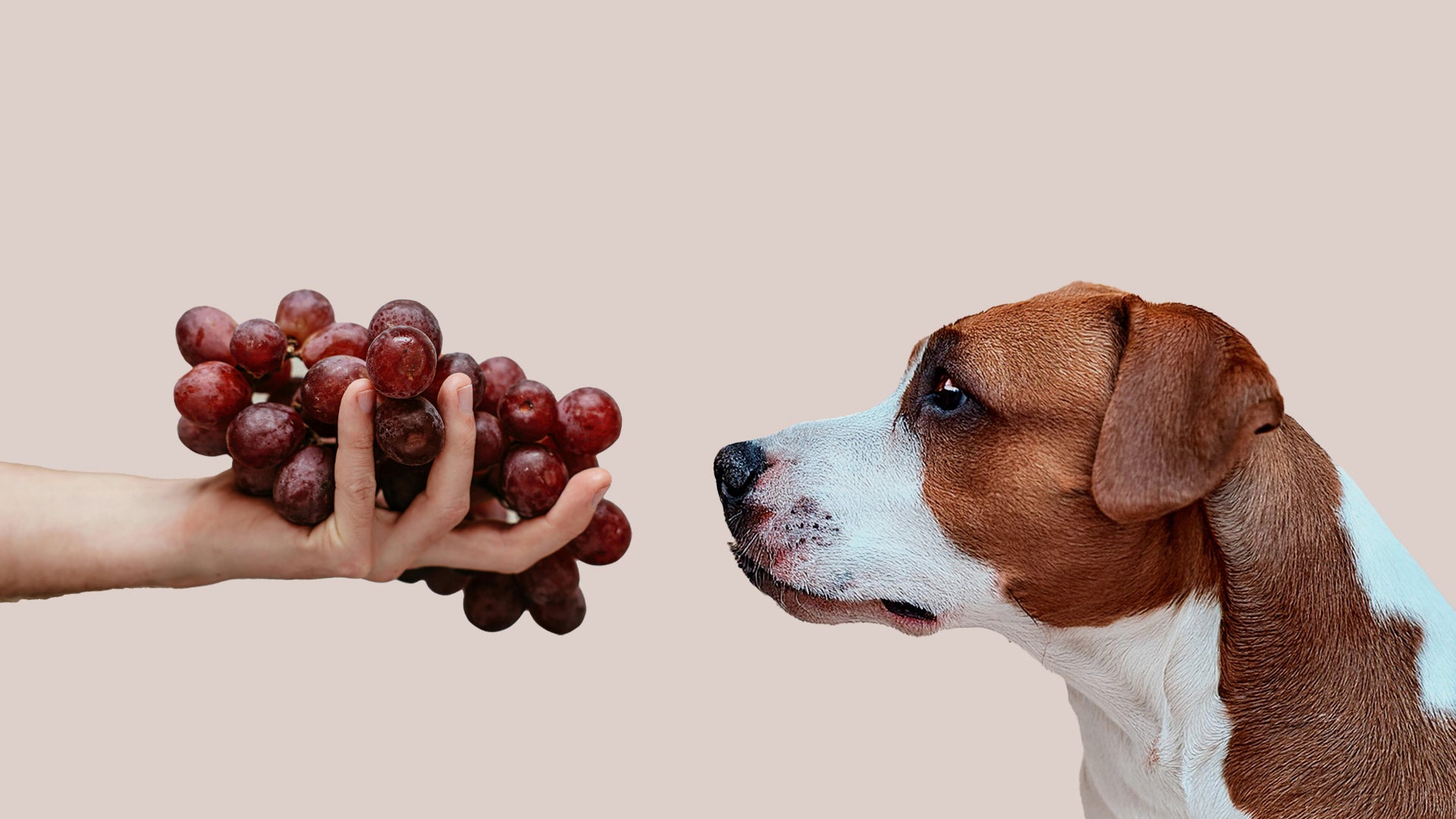Grapes may be a go-to snack for humans, but for dogs, grapes are toxic, even in small amounts. Learn why grapes are bad for dogs, symptoms of toxic ingestion, and how to prevent your furry friend from eating grapes in the first place.
The Reason Why Dog Can't Eat Grapes
Grapes are extremely toxic to dogs and can lead to severe health problems, mainly acute kidney failure. While animal experts and veterinarians have known that grapes are poisonous to dogs for years, they weren’t exactly sure why. It’s been difficult to pinpoint the exact mechanism at work. Throughout the years, researchers have said that toxicity could be down to a mycotoxin (a toxic substance from fungus or mold) or a salicylite drug (like aspirin) that naturally occurs in grapes.
But research now suggests the likely culprit could be a toxic compound found in grapes called tartaric acid. The ASPCA Animal Poison Control Center (APCC) published a study that found tataric acid to be the likely toxic component in grapes and raisins. Tartaric acid is responsible for the tart flavor of grapes. The ASPCA’s research explains why some dogs experience mild symptoms while others have severe kidney damage. They found that it's hard to predict toxicity because tataric acid concentration can vary so much in grapes. This helps vets and dog parents understand why dogs can’t have grapes and just how important it is to keep grapes out of reach.
Can a Single Grape Kill a Dog?
Can dogs have just one grape? No, unfortunately, when it comes to grapes and dogs, even a single grape could be fatal. The severity of the reaction to a grape can vary massively from one dog to another. Tartaric acid in grapes can cause kidney damage and other health issues. Even a small amount of grapes can be dangerous, so it’s crucial they are kept out of reach.
Grapes are poisonous to dogs, and if you suspect your pup has ingested grapes, treat it as an emergency and seek veterinary care immediately.
Signs and Symptoms of Toxic Ingestion
The reason why dogs can’t eat grapes is because grapes can cause kidney failure in dogs. There’s no established toxic dose for grapes, and even small amounts can cause health problems.
Here’s an overview of the signs and symptoms of grape toxicity in dogs:
Early signs (within the first 12 hours):
- Vomiting
- Diarrhea
- Lethargy (unusually still)
- Loss of appetite
Later signs (24-48 hours later):
- Kidney failure
- Decreased urination or no urination at all
- Increased thirst (panting, dry nose, and pale gums)
- Increased urination (early sign, before kidney failure)
- Abdominal pain
- Weakness
- Tremors
- Seizures
What to Do if Your Dog Has Eaten a Grape
Grapes are toxic to dogs, and if your dog has ingested them, it’s essential to act fast and follow the below steps:
- Call your vet if your dog eats any amount of grapes, raisins, currants, or sultanas. If your vet’s office is closed, find a 24-hour emergency vet office and contact the Pet Poison Helpline at 855-764-7661.
- Not all dogs are immediately unwell, so you should still contact your vet if your dog has eaten grapes but isn’t showing symptoms.
- Watch your dog closely for symptoms such as vomiting or increased thirst.
- Follow your vet’s exact instructions.
How is Grape Poisoning Treated?
If your dog eats grapes, raisins, currants, or sultanas, treatment aims to stop the poison from getting to the kidneys to prevent or minimize any damage. Sometimes, your vet may induce vomiting to empty the stomach and reduce further absorption. Treatment usually involves giving activated charcoal, which helps bind a toxin in the stomach and slow absorption.
In cases where the dog has ingested a lot of grapes or the above treatment isn’t showing signs of improvement, your vet may recommend 48 hours of IV fluids to flush the toxin out. If the dog is still only producing a little bit of urine, your vet may use medications to activate the kidneys. Your vet will monitor your dog’s kidney function throughout treatment and respond as necessary.
How Can I Prevent Grape Poisoning from Happening?
We know why grapes are bad for dogs and the potential damage they can cause. By knowing the possible ways your dog could eat grapes, you can prevent grape poisoning from happening. Here are some ways dogs can eat grapes to be aware of:
- If grape or grape-containing foods are left out on the counter, a curious dog may jump up and take a bite without you noticing.
- Dogs can raid through trash, so make sure you dispose of any grapes, raisins, or currants safely and securely.
- Watch out for grapes growing on a vine in the garden or near the house where your dog can reach.
- Be careful when giving your dog human food or treats, and make sure it doesn’t contain any ingredient that’s toxic for dogs, like grapes or chocolate.
- Make sure that no grapes or grape-containing foods are left out in easy-to-reach places for your dog.
What Other Common Foods are Toxic to Dogs?
Grapes, raisins, sultanas, and currants are all toxic to dogs because they contain the same toxic compound called tartaric acid. But what other food can dogs not eat?
As a dog parent, we need to learn which foods are toxic for dogs. By knowing the list of no-go foods, you can keep these foods out of reach from day one.
Here’s a detailed list of foods that are toxic to dogs:
- Grapes and raisins
- Chocolate
- Onions, garlic, and chives
- Macadamia nuts
- Xylitol
- Avocado (pit and skin)
- Alcohol
- Caffeine
- Salt
- Yeast dough
- Moldy foods
Some foods aren’t toxic to dogs but should still be avoided, including:
- Fatty foods (like fried foods or fatty meat like bacon)
- Sugary foods (cookies, candy, etc.)
- Salty foods (chips and salty snacks)
- Bones (cooked bones can splinter, and large raw bones are a choking hazard)
Safe Treat Options for Your Dog
While grapes are toxic for dogs and definitely something to keep out of reach, there are some fruits and vegetables dogs can eat.
Here’s a list of dog-friendly fruit and vegetables:
Fruits:
- Apples (without seeds)
- Bananas
- Blueberries
- Cranberries
- Mango (without pit)
- Pineapple
- Raspberries
- Strawberries
- Watermelon
Vegetables:
- Broccoli (in moderation)
- Carrots
- Celery
- Cucumbers
- Green beans
- Peas
- Pumpkin
- Sweet potatoes
While dog-friendly fruits and vegetables can be an occasional, healthy treat for dogs, human treats shouldn’t make up more than 10% of your dog’s daily caloric intake. We usually add salt or spices to our meals for extra flavor, but that’s not safe for dogs. Any dog-safe human food you choose to offer should be completely plain. While that may sound boring to us, it’s best for dogs as you don’t want to give salt, sugar, or spices that could cause health issues.
If you’re looking for the perfect treat for your dog, a safer (and easier) alternative is to give your pup treats formulated especially for dogs. Why not try our beef jerky dog treats? Our low-calorie treats contain real smoky beef as the number #1 ingredient, packed with protein and flavor for the ultimate treat.
FAQs
Are grape stems, vines, or leaves toxic to dogs?
Although grapes are bad for dogs, technically, the other parts of the plant, like stems, vines, and leaves, are not as toxic. But, grape stems, leaves or vines may still cause an upset stomach. It’s safer to avoid letting your dog eat anything associated with grapes. There’s also a risk that eating grape vines, leaves, or stems could lead to accidental ingestion of grapes themselves, which can be very dangerous.
My dog drank wine. Will he be ok?
If your dog accidentally drinks wine, there are two concerns: grapes and alcohol content. Depending on the amount, alcohol can lead to alcohol poisoning in dogs, causing symptoms like vomiting, diarrhea, and difficulty breathing. There are currently no reports of grape toxicity from wine in dogs, but it could still be toxic. If your dog has drunk wine accidentally, contact your vet or the Pet Poison Helpline.
Can my dog eat raisin bread?
Now you know why grapes are toxic to dogs, what about raisin bread? Any raisin-containing product should be considered toxic and off-limits to dogs. This includes foods like raisin bread, yogurt-covered raisins, and oatmeal raisin cookies. If your dog has eaten raisin bread or any raisin-containing food, contact the ASPCA Animal Poison Control Center or Pet Poison Helpline as soon as possible.
Is grape jelly toxic to dogs?
There is no known safe amount of grape jelly dogs can eat. As grape jelly can include grapes, it’s best to avoid grape jelly and any grape-containing foods like grape jam or grape juice. Grape jelly also contains a lot of sugar and may contain xylitol, which is toxic for dogs.
Keeping grapes and other toxic foods out of reach for dogs is crucial. A proactive approach to safety, a healthy diet with high-quality dog food like Jinx, and regular exercise all support your dog’s overall health and well-being, helping your furry friend to thrive.
At Jinx, we're here to upgrade the way you care for your dog by providing holistic nutrition made with thoughtful formulation, real ingredients, and a whole lot of love.

